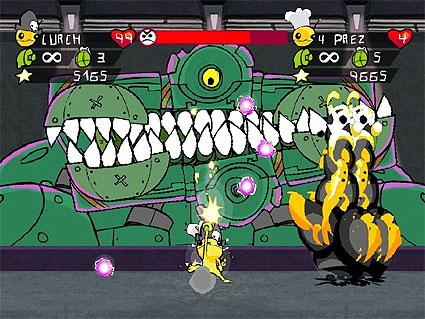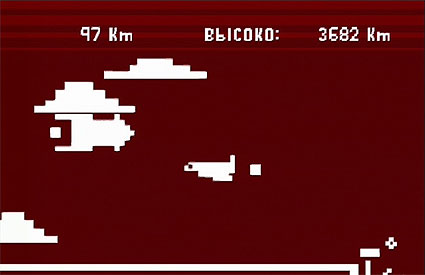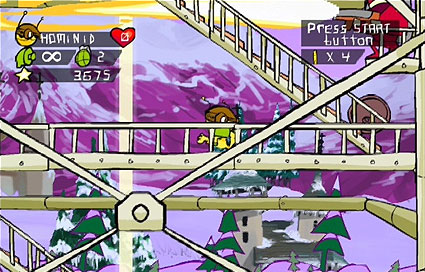There's something missing from my controller. Where did my Turbo button go? My thumb is growing tired. In fact, my whole hand is kind of cramping up. Stupid Wavebird. But it's so freeing! No more dragging consoles across the carpet so I can game on my couch! But still, where exactly did my damn Turbo button go?
For years the Turbo button mystified me. When I was young I wasn't sophisticated enough to understand the relevance of a Turbo button. I'd stab it on my friend's NES Advantage merely so I could hear the satisfying 'click' it made and watch the red light flick on and off. Call me naive, but back in those days I believed every button on a controller was there for a reason and that every game would utilize each button or trigger equally. But as my friends grew up and the years passed, I got my hands on new controllers with new Turbo buttons. Controllers like the satisfyingly heavy Sega Arcade Power Stick had even more clicky buttons and was incredibly sleek. I still didn't know how utilize the Turbo (or Megafire) button properly though, or the real reason why they were there but I was all too happy to press them over and over again. And when I met the TurboGrafx 16, its little Turbo switches confused me more than anything else until the day I realized that I could use them to spin faster in Bonk's Adventure.

The years went by and Turbo buttons fell off of first party controllers, they just disappeared and I didn't really think much of it until I spent an hour with Alien Hominid. I started asking myself questions like 'Where is the Turbo button on my Wavebird?', 'Why is my thumb working overtime?' and 'When was the last time I cleaned this controller?' I hadn't thought about the Turbo button in ages but Hominid brought these memories all rushing back, and that's just quite the type of game Hominid is: on the surface it appears to be a visually brazen side-scrolling shooter that brings nothing but a slapdashery of new veneer (and exhausted thumbs) to a tired and nigh-forgotten genre. But if you spend a bit of time with it, Alien Hominid is exposed as a love letter to old-school gaming from developers the Behemoth to gamers like myself.
As has been reported ad nauseam by the gaming media and Alien Hominid's packaging, the two-dimensional shooter began its life in the vacuum of the Flash novelty site Newsgrounds.com. Several years after the quirky Flash prototype garnered acclaim from thousands of Newgrounds users, the Behemoth completely redesigned the game from the ground up, wearing their influences on their sleeves and scribbling them in the margins of Hominid's design document. Hominid takes the simple 'estranged man trying to escape a planet out to get him' genre and turns it on its ear: the lost man in this case is no human, but an alien whose fly-by of Earth resulted in its ship crashing to the planet and subsequently stolen away by men in black. The Hominid then spends 16 levels shooting through a variety of FBI agents, communists and a variety of monstrous, mechanical (and organic) creations to get its ship back. Of course, the alien isn't exactly defenseless. In addition to its standard gun, all of the traditional weapon upgrades are available: spread, plasma, flamethrower, nothing you haven't seen in prior shooters. The primary mechanics of Alien Hominid, running, jumping, shooting (and occasionally lobbing a grenade), are rather routine and gave me severe Contra flashbacks but visually, there's not much to compare Hominid to, at least not as far as console titles are concerned. Hominid's hand-drawn look certainly impresses with its sense of character and fluidity, and recalls some of Keith Giffen's work brought to life. It looks fantastic, but the real allure is in the level design.

The great attraction of Alien Hominid is in the details, the homages embedded throughout the game. Playing Hominid is similar to having a quote contest with your best friend, the two of you reliving (and embellishing) your favorite gaming memories and mulling over the the best of times. When you're not mulling over where your Turbo button is, you realize the yeti just jumped on is a monster cribbed from Rampage, even down to it chomping down on soldiers and smashing stories-high structures. One moment you're doing the traditional run & gun and the next, you're in your spaceship Asteroids-style, firing your engines across space in search for your ship's missiles. A few levels later while en route to a boss, the surrounding rails and positioning of the guarding soldiers can't help but evoke memories of Strider, and the barrels rolling down towards you? Quintessential Donkey Kong. The PDA mini-games hark back to the days of Lode Runner and I'm sure there are many, many more referential moments I'm missing. What is best is that these gameplay referential twists and turns enhance and break up the potential monotony of Hominid's run-and-gun style. It simultaneously causes, and whets a desire for several old-school gameplay styles. In many ways, Hominid can be looked at as a gaming time capsule of sorts, one certainly more engrossing than the latest Atari Retrospective or Namco Museum collection.

Since Alien Hominid does recall the games of old, it's odd that it lacks some key features that its predecessors practically standardized, namely the absence of eight-way directional aiming. Yes, you're inhibited to only shooting in four directions: up, down, left and right. It feels strangely limiting considering the games that Hominid cribs, extolls and were directly inspired by utilized eight-directional aiming. It seems to be glaring omission, a nuisance that possibly betrays the game's Flash roots. Similarly troublesome the action gets hairy, really hirsute, during some terribly bullet-ridden times when it's difficult to make out forthcoming projectiles causing more than a few unfair deaths. And for a game where the sound effects are repeated practically to the tune of 30 fx per second, the sounds ring hollow and are poorly sampled, which stand in sharp contrast to the excellently evocative and energetic soundtrack (even if the loops are occasionally repeat too quickly). The game is definitely short to boot, but the mini-games and multiple difficulty levels will command more time, plus it's not as if you're laying out a full $50 for the game (and if you are, you're making Andrew Jackson very, very sad) so brevity isn't terribly problematic.

Alien Hominid is an impassioned shooter, one that was created in tribute to the games that the developers adore and they do it with a bit of flair. Hominid dredges up these gaming memories in a brilliantly stylized manner, and despite the four-way directional aiming and cheap deaths it remains enjoyable. Sure, it made my thumb work a bit more than I'd like but it served to remind me of the good old days, when side-scrolling shooters were in their prime and not doing the tarantella in retail outlets. The heyday of shooters may have passed, but Alien Hominid serves as a reminder of the glorious games of our past while giving a pleasantly quirky current generation experience.



